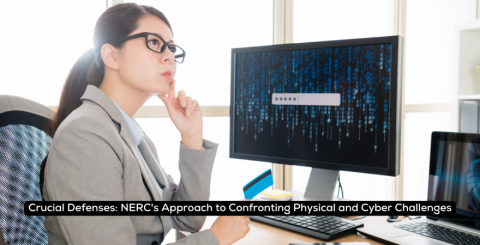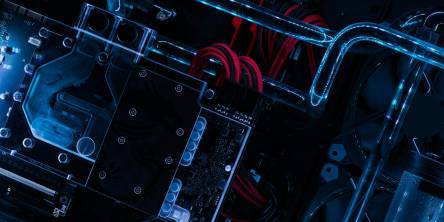Crucial Defenses: NERC's Approach to Confronting Physical and Cyber Challenges

Seeking cutting-edge strategies to secure North America's interconnected grids? Comprehending NERC's multifaceted approach is key. Delve in to uncover the organization's far-reaching initiatives spanning standards, collaboration, and technology to conquer the complex threats endangering our electricity infrastructure.
The reliable and resilient operation of North America's bulk power system (BPS) is vital for economic prosperity, public health, and national security. As the Electric Reliability Organization for North America, the North American Electric Reliability Corporation (NERC) undertakes the crucial mission of safeguarding this expansive and complex critical infrastructure.
NERC's multifaceted strategies encompass both physical and cyber domains to address the diverse threats facing today's interconnected grids. From extreme weather and seismic events to cyber intrusions and electromagnetic pulses, the modern bulk power system faces unprecedented risks. This article explores NERC's proactive and adaptive efforts to uphold reliability and augment resilience across the BPS.
NERC's Forward-Looking Approach to Reliability and Security
NERC's 2023 State of Reliability report spotlights the bulk power system's resilience against escalating stresses over the past year. Despite frequent severe weather events, no load shedding resulting from transmission volatility was reported in 2022. Key transmission reliability metrics have also shown gradual improvements over the past decade, including a reduction in transmission misoperations.
Driving this progress is NERC's commitment to rigorous reliability standards, infrastructure investments, threat monitoring, and fostering robust collaboration between industry and government partners. Initiatives like NERC's grid security exercises bring together stakeholders to strengthen incident response capabilities. The organization also provides vital education programs and shares timely information to mitigate emerging risks.
Looking ahead, NERC aims to further improve transmission system availability and minimize outages through technology upgrades, real-time monitoring, and transmission operator training. As threats evolve, NERC continues demonstrating a proactive approach to reliability and security.
Strengthening Physical Security Standards
Alongside weather events, physical threats such as vandalism, theft, and sabotage jeopardize grid assets. NERC has implemented various mandatory standards focused on physical security, including the NERC CIPs standards. The NERC CIPs standards encompass requirements for access controls, personnel training, incident reporting, and safeguarding of sensitive bulk electric system information. Rigorous audits of CIPs standards compliance help motivate continuous enhancement.
The NERC CIP-014 standard is specifically focused on identifying critical facilities and protecting them from physical attacks. A rigorous evaluation of CIP-014 motivated important enhancements to the criteria for identifying critical assets. NERC continually reassesses the efficacy of its standards through feedback surveys, audits, and lessons learned from grid events.
NERC further assists implementation through its Physical Security Reliability Guideline. This voluntary guideline provides methodologies and examples of physical threat mitigation, risk management programs, and strategies to detect tampering. Complimenting mandatory standards with detailed guidelines and technical resources helps drive effective security practices.
Adapting to Evolving Cyber Threats
Cyber intrusions pose another set of risks for bulk power system operations. The FBI reported a rise in cyber attacks on the energy sector in 2022, including ransomware and data breaches. NERC collaborates closely with the Department of Energy, Homeland Security, and the Electricity Information Sharing and Analysis Center (E-ISAC) to monitor threats and provide strategic guidance to industry.
To bolster cyber resilience, NERC integrated explicit cybersecurity considerations into its planning standards. This included redefining the "adequate level of reliability" to address contemporary cyber risks. NERC's roadmap focuses on holistic cyber-informed planning, recognizing interdependencies between cyber and physical systems.
NERC also provides detailed guidance on multi-factor authentication, network segmentation, and other best practices for cyber hygiene. As advanced adversaries emerge, continuous awareness, information sharing, and innovation in cyber defenses will remain imperative.
Security Through Partnership and Collaboration
NERC understands that resilience requires collective action among policymakers, industry leaders, and security experts. The E-ISAC facilitates this collaboration, serving as the electric industry's 24/7 information sharing and incident response center. The Electricity Subsector Coordinating Council and various NERC advisory groups further unify strategies between public and private stakeholders.
NERC routinely partners with governmental agencies including the Department of Energy, Homeland Security, and Public Safety Canada. In addition to sharing timely threat intelligence, these partnerships enable the development of security advisories and coordinated responses to mitigate grid disturbances.
The scale and diversity of North America's grids necessitate an integrated defense spanning political boundaries and industry segments. NERC continues providing the critical leadership and collaboration platforms to secure the BPS against modern threats.
The Ongoing Mission to Strengthen Grid Resilience
NERC's multifaceted approach to reliability, security, and resilience represents forward-thinking and adaptive grid management. The bulk power system has demonstrated its enduring resilience against growing challenges. However, the risk landscape will continue evolving as climate change, cyber attacks, electromagnetic threats, and other hazards intensify.
Continuous assessment of reliability risks along with coordinating strategies and sharing expertise between industry and government partners will remain imperative. Investments in grid modernization and new technologies must be complemented by rigorous cyber and physical security standards.
While NERC has raised the bar for bulk power system protections, securing the expansive North American grid demands the sustained commitment of regulators, asset owners, technology partners, and security experts across jurisdictions. As the Electric Reliability Organization, NERC provides an indispensable foundation for this mission. But maintaining an adaptable and resilient grid is ultimately a shared endeavor vital for public welfare, economic vitality, and national security.
Conclusion
NERC's multifaceted approach to security, reliability, and resilience exemplifies effective modern grid management. As emerging technologies introduce new risks, continuous adaptation and coordination are crucial for confronting the challenges ahead. While the bulk power system has demonstrated enduring reliability, NERC continues to raise the bar for security, driving risk management innovations and fostering robust collaboration.
The journey toward a resilient power grid future requires the collective will and ingenuity of industry, government, and partners across North America. NERC's robust strategies provide a critical foundation, but securing the grid's crucial role in our society remains an ongoing and shared endeavor.
Frequently Asked Questions
1. What are the key physical security standards NERC has implemented to protect the grid?
ERC's CIP-014 Reliability Standard is crucial for ensuring physical security, focusing on identifying and protecting critical bulk power system assets. The organization continually evaluates and updates these standards to address the dynamic risk environment.
2. How does NERC address the cybersecurity threats to the bulk power system?
NERC adopts a multifaceted approach to cybersecurity, including the development of CIP standards, collaboration with industry and government for threat intelligence sharing, and implementing robust security measures like multifactor authentication and malware detection.
3. What role do industry and government collaborations play in NERC's security strategy?
Collaborations are pivotal, with entities like the E-ISAC and governmental agencies working together to provide timely threat intelligence, develop security advisories, and foster a collective defensive strategy against both physical and cyber threats.
Similar Articles
In today's technologically advanced landscape, understanding heat distribution is critical for enhancing efficiency and safety across various sectors. Infrared thermography, a pivotal imaging technique, has revolutionized how professionals view and analyze thermal performance.
In this digital age, there are many options available for marketing, but the one that stands out as one that can transform the marketing realm is programmatic connected TV (CTV). The programmatic CTV approach for advertising shows the changing trend in how brands would like to connect with their audience.
PHP has a dominant market position, with over 79% of websites powered to some degree. Developers majorly utilize organized and leveled PHP basic functions, known as PHP frameworks, to create flexible output.
The nonstop hum of machines around us, from the humongous industrial complexes to the processors within the gadgets, shapes our everyday lives. These mechanical advancements have become essential, driving everything from fundamental necessities to our vehicles, airplanes, and so forth.
New methods of managing a Pilate business are transforming the way studios operate. It simplifies routine tasks and helps fitness businesses to grow and facilitate their customers in various ways.
Discover if the S23 Ultra case is compatible with the S24 Ultra. Get insights on fit, protection, and functionality in this comparison.
In the era of astoundingly quick technological progress, organizations are increasingly feeling the need to adjust to the evolving market demands and their requirements by embracing digital transformation
With the rise of mobile devices and the ever-growing demand for cross-platform solutions, businesses are constantly seeking efficient ways to develop applications that can be used on multiple platforms. This is where Kotlin Multi Platform comes into play. Kotlin Multi-platform is a versatile technology that allows developers to write code once and deploy it on various platforms such as Android, iOS, and web.
Discover reliable network cabling solutions ensuring seamless connectivity for remote work. Enhance productivity with consistent connections anywhere.









